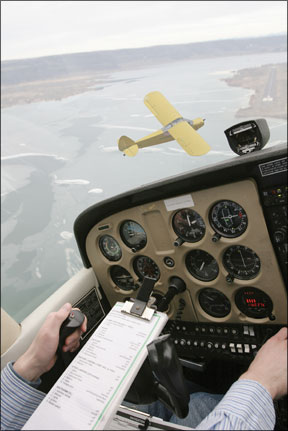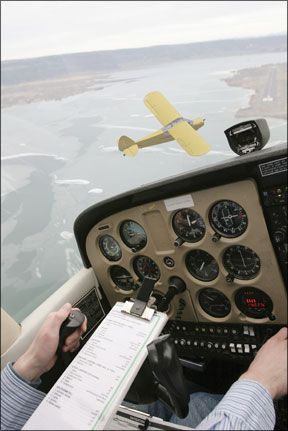In August 8, 2009, a Piper PA-32R-300 Lance and a Eurocopter AS350BA collided over the Hudson River between New Jersey and Manhattan. The pilot and two passengers aboard the airplane, and the pilot and five passengers aboard the air-tour helicopter were killed. Both aircraft were substantially damaged. 288 On September 14, 2010, the National Transportation Safety Board (NTSB) held a public hearing to approve its probable cause finding. The NTSB determined “the inherent limitations of the see-and-avoid concept…made it difficult for the airplane pilot to see the helicopter until the final seconds before the collision.” The NTSB also found fault with a Teterboro Airport (TEB) tower controller, who was on a personal telephone call as the Piper departed the facility. In response, the Aircraft Owners and Pilots Association (AOPA) labeled the NTSBs move “rare” and AOPA Air Safety Foundation President Bruce Landsberg questioned the probable cause findings indictment of see-and-avoid over the controllers distraction. The Board also listed three contributing factors. For more details, as well as the complete text of NTSB Vice Chairman Christopher A. Harts associated statement in which he concurred in part and dissented, see the sidebar on page 18. Indeed, by focusing primarily on see-and-avoid as the first probable cause of this accident, the NTSB overrode its staffs recommendation to cite the controllers distraction. Whats going on? Has the NTSB declared see-and-avoid dead? What was ATCs role in this accident and did procedural failures allow the two aircraft to collide? What else has or can be done to prevent this sort of collision? Immediate Aftermath In fact, much was done in this collisions immediate aftermath. In our September 2009 issue, we highlighted the speed with which the FAA formed a New York Airspace Task Force and adopted its recommendations. As we wrote at the time, the task force recommended airspace restructuring, new pilot operating rules, an entry point into the Hudson River airspace from Teterboro, standardizing New York area charts and developing new training for pilots, air traffic controllers and businesses operating in the area. Those recommendations were implemented by FAR Part 93, Subpart W, which established the New York Class B Airspace Hudson River And East River Exclusion Special Flight Rules Area. Additionally, the FAA created online training materials to familiarize pilots with the new rules and procedures. Unlike similar training for the Washington, D.C. Special Flight Rules Area, the new training is not required before operating in the airspace. By all reports, the new rules seem to be working well (but if readers think otherwise, wed like to hear about it). “Personal phone call” Perhaps the most effective evidence collected by the NTSB and considered by the Board involves the TEB tower controller. In its 3.5-minute animation video, the words “personal phone call” appear for most of it, describing the TEB local controllers activity while simultaneously attempting to hand off the Lance to controllers at nearby Newark Liberty International Airport (EWR) and work other traffic. During this time, the TEB controller issued a frequency change to the Lances pilot, who missed a digit in his readback. The TEB controller failed to catch or correct the error, due at least in part to the personal phone call. One result of the failed handoff was Newarks inability to warn the Lance of the helicopter, which had just departed a riverside heliport on a sightseeing flight. As the NTSB stated, “The Teterboro Airport local controller did not correct the airplane pilots read back of the Newark Liberty International Airport tower frequency because of the controllers nonpertinent telephone conversation and other transmissions that were occurring” and “did not provide continual traffic advisories to the airplane pilot, as required.” In effect and thanks to the TEB controller missing and failing to complete the handoff the Newark, the Lance wasnt talking to anyone as it cruised down the rivers west bank. The NTSB blamed this on the TEB controller, yet still found “the inherent limitations of the see-and-avoid concept” as the accidents primary probable cause. Major Dindings In fact, the NTSBs list of findings included the following: “The Teterboro Airport local controller unnecessarily delayed transferring communications for the accident airplane from Teterboro to Newark Liberty International Airport (EWR), which prevented the EWR controller from turning the airplane away from Hudson River traffic and having the airplane climb directly into Class B airspace.” “The Teterboro Airport local controller did not provide continual traffic advisories to the airplane pilot, as required; such advisories would have heightened the pilots awareness of traffic over the Hudson River.” “The airplane pilot may have believed that no other potential traffic conflicts existed because he had not received additional traffic advisories, but the pilot was still responsible for seeing and avoiding other traffic.” “The Teterboro Airport local controller did not correct the airplane pilots read back of the Newark Liberty International Airport tower frequency because of the controllers nonpertinent telephone conversation and other transmissions that were occurring.” “The airplane pilots incorrect frequency selection, along with the Teterboro Airport controllers failure to correct the read back, prevented the Newark Liberty International Airport controller from issuing instructions to the airplane pilot to climb and turn away from traffic.” Other Information Interestingly, both aircraft were equipped to receive data from the FAAs Traffic Information Service (TIS). The Piper carried a Garmin GTX 330 mode S transponder, had the appropriate software and datalink interface, and the FAA confirms TIS data were displayed on its Garmin GNS 530. The helicopter also was equipped with a mode S transponder plus the hardware and software to display TIS data on its Garmin GNS 430. In other words, both accident aircraft were equipped with the FAAs current-standard collision avoidance system. The NTSBs report included a cockpit visibility study, concentrating on the view from the Pipers front seats, along with reconstructed TIS data, to suggest what its pilot and front-seat passenger may have seen in the moments leading up to the collision. The helicopters flight path-initially westerly as it climbed, then southbound, approximating the Pipers heading-should have afforded its pilot opportunity to acquire the Piper, either visually or via TIS. Apparently, no such study was performed for the helicopter, which had climbed to 1100 feet msl, 100 feet higher than its operators procedures and its FAA-approved air tour safety plan called for. According to the NTSB, “the helicopter pilot would not have been able to see the airplane because it was above and behind the helicopter.” However, the NTSB “concludes that the airplane would likely have been in the helicopter pilots field of view until 32 seconds before the collision.” Again, according to the NTSB, “the helicopter was also equipped with a cockpit traffic display, which, if operating as designed, should have provided the helicopter pilot with information about the airplanes location.” Blame The GA Guy? As is the case in almost any accident-and as the NTSB reports-several factors were at work in the moments leading up to this collision. Chief among them is the TEB controllers personal phone call, which at least contributed to him missing an incorrect readback from the Piper. As one result, the Piper was not handed off to the EWR controller, who might have advised its pilot of the merging helicopter. And lets not forget both aircraft were equipped with datalinked traffic information, the presence of which also failed to prevent the collision. Yes, both pilots failed to see and avoid the other. But numerous other factors were involved, many of which the NTSB listed as contributing to this accident. The NTSB just as easily could have determined faulty ATC procedures and the TEB controller, along with TISs inherent limitations and the helicopters altitude, were primary. Is the see-and-avoid concept dead? Not by a long shot, despite blaming the Pipers pilot for failing to avoid the helicopter. Many other factors and failures were involved. Instead, the NTSB chose to indict a well-proven concept rather than the many other people, technologies and institutions also at fault.




